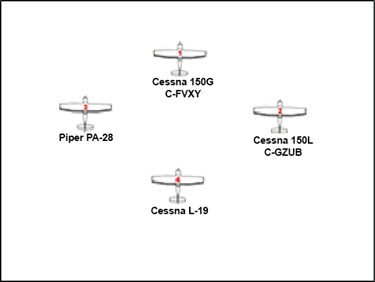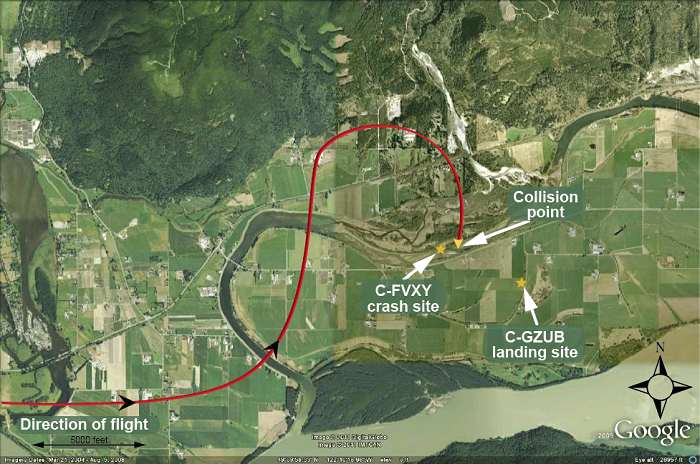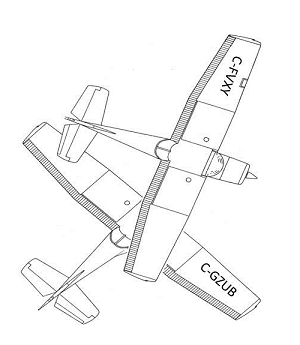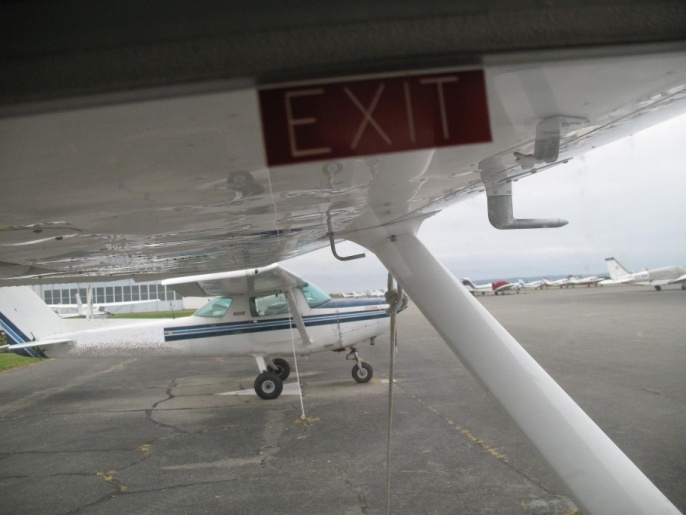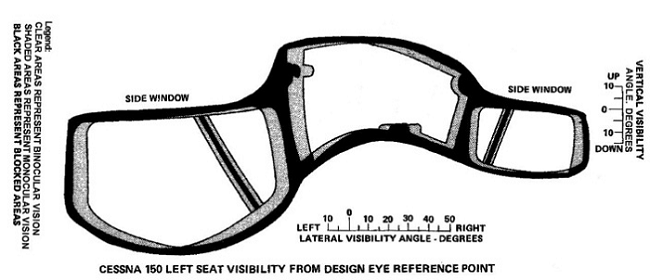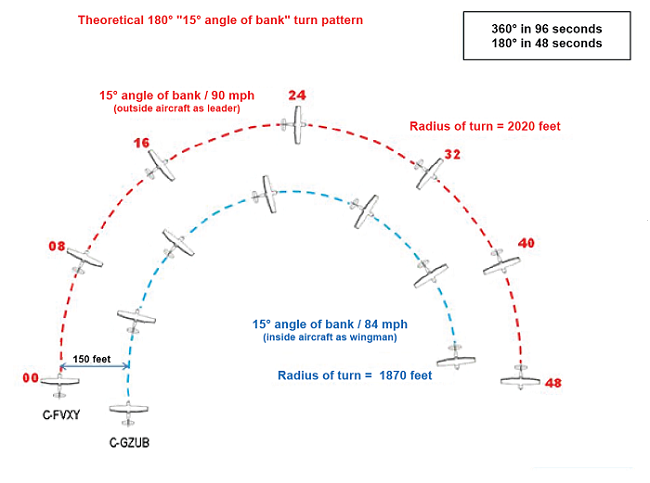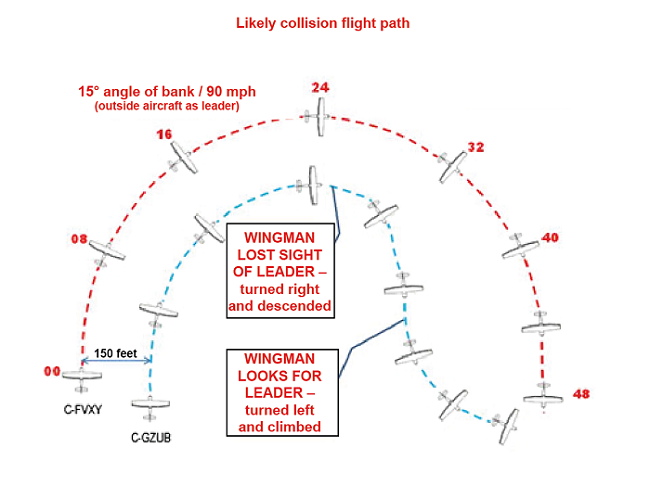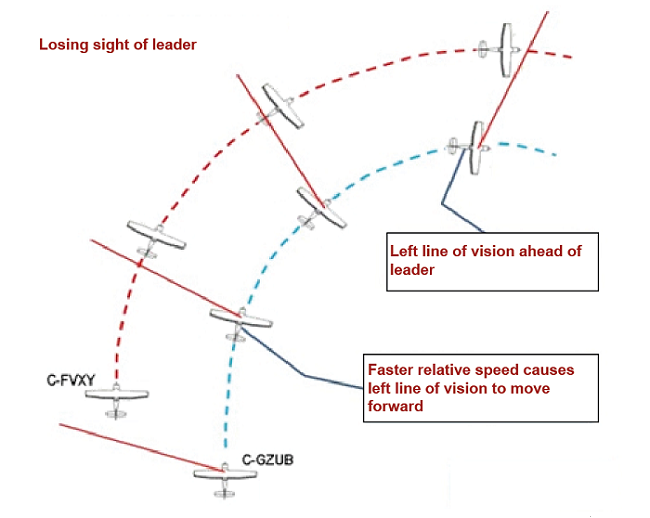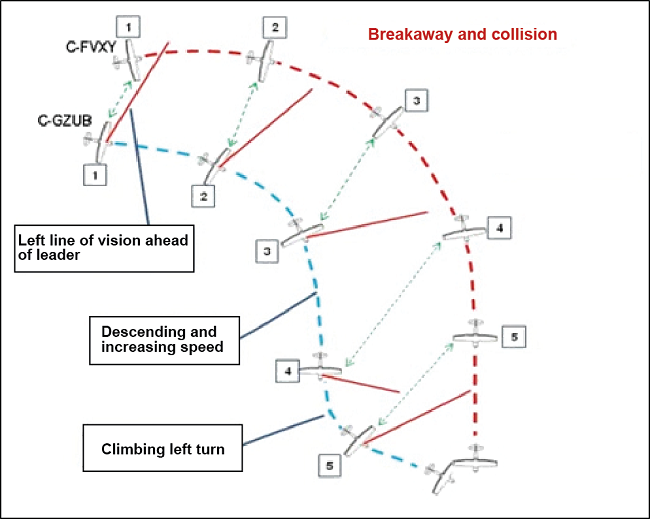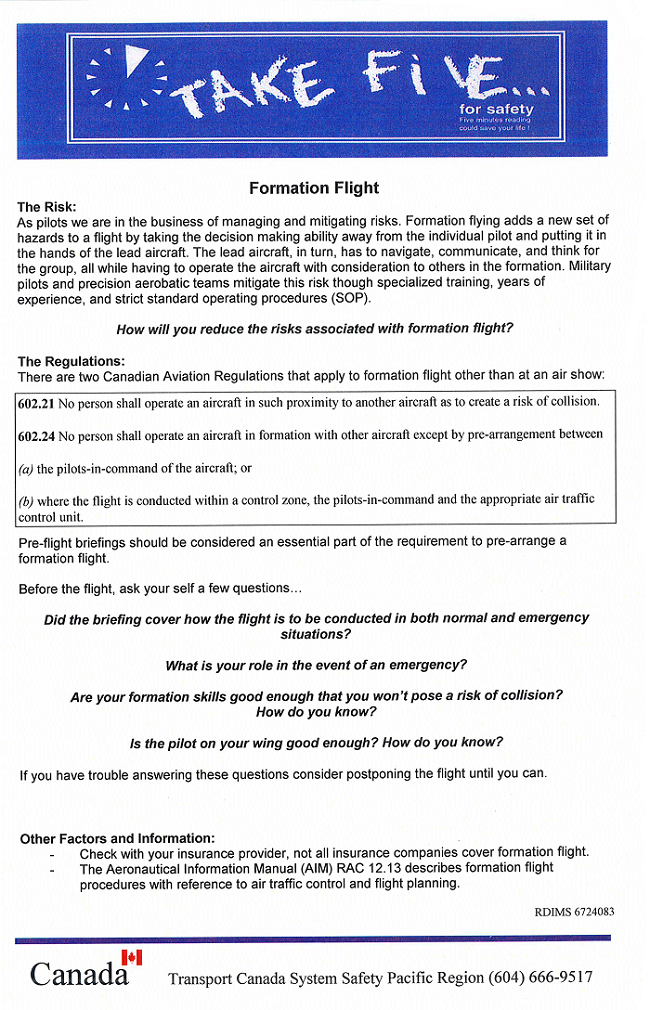Midair collision
between Cessna 150G C-FVXY and
Cessna 150L C-GZUB
Dewdney, British Columbia
The Transportation Safety Board of Canada (TSB) investigated this occurrence for the purpose of advancing transportation safety. It is not the function of the Board to assign fault or determine civil or criminal liability. This report is not created for use in the context of legal, disciplinary or other proceedings. See Ownership and use of content. Masculine pronouns and position titles may be used to signify all genders to comply with the Canadian Transportation Accident Investigation and Safety Board Act (S.C. 1989, c. 3).
Summary
At about 1600 Pacific Standard Time in daylight conditions, a group of 4 light aircraft took off from the Langley Regional Airport in Langley, British Columbia, for a local formation flight to Chilliwack, British Columbia. At about 1615, during a turn, the Cessna 150G (registration C-FVXY, serial number 15066711) and the Cessna 150L (registration C-GZUB, serial number 15074143) collided. The 2 aircraft briefly descended joined together and out of control, but at about 400 feet above ground level, they separated. C-FVXY broke up in flight and fell into a shallow slough; the 2 occupants were fatally injured and the aircraft was destroyed. The pilot of C-GZUB regained control of the aircraft and landed in a farm field without injury; however, the aircraft was substantially damaged as a result of the collision. There was no fire and the emergency locator transmitter on C-FVXY activated upon impact with the slough.
1. Factual information
1.1 History of the flight
Earlier that afternoon, a local group of 4 pilots and 2 crew members decided to carry out a short flight to practise formation flying in the Mission-Chilliwack area. The group comprised a Cessna 150G, a Cessna 150L, a Cessna 305A (L-19), and a Piper PA-28-180. The group assembled for a formation flight pre-flight briefing at the Langley Regional Airport, where all 4 aircraft were regularly based. As discussed at the meeting, the round-trip flight was a daylight recreation flight, in accordance with the visual flight rules (VFR), to the Chilliwack Municipal Airport. Originally, the leader had planned to fly to, and land at, a popular site near Harrison Mills, British Columbia, and then conduct a debriefing on the ground. However, following a discussion about the remaining daylight, the leader chose to fly to Chilliwack instead. The pilots' intentions were to practise simple formation flying enroute, during which they would carry out basic station-keeping (maintaining position) with simple turning manoeuvres, in a loose diamond pattern (Figure 1). The briefing was straightforward and succinct, and did not include discussion of emergency or contingency procedures. However, a briefing was given by the leader about the join-up procedures, as well as instructions in the event a pilot could not find the formation, and about the formation break-out procedures at Chilliwack Municipal Airport.
Three of the pilots in the group were familiar with formation flying because they had flown together many times at various fly-past events and had practised over the Lower Mainland of British Columbia. As a newcomer to the group, the pilot of the Cessna 150L (C-GZUB), having previously accompanied other pilots during two formation flights, was flying as the pilot of his own aircraft in the formation. The group planned to introduce the newcomer progressively to the basics of formation flying. They discussed having an observer/spotter fly with the pilot of the Piper PA-28-180 for the outbound leg to Chilliwack, and then change aircraft and return with the pilot of C-GZUB on the leg back to Langley. The pilot of C-GZUB, however, was unwilling to have another person in the aircraft with him because of likely distraction.
The lead aircraft was the Cessna 150G (C-FVXY) with 2 occupants on board. On the right-hand wing of the leader, in the number 2 position, was the Cessna 150L (C-GZUB) with only the pilot on board. Also in the group was the Piper PA-28-180, with 2 occupants on board, in the number 3 position on the leader's left side. The solo Cessna 305A (L-19) was in the number 4 position at the rear of the other 3 aircraft.
At about 1600, 1 the 4 aircraft took off separately, but in a pre-arranged sequence, from the Langley Regional Airport and cleared the control zone to the north-east. In the next few minutes, the aircraft joined up and formed the diamond pattern as briefed. After the aircraft had settled in together, they flew in stable formation for several minutes as they proceeded eastwards in the Glen Valley, above the Fraser River, towards the township of Mission, British Columbia. During this time, the flight carried out gentle turns, with the flight leader communicating to the group on the appropriate radio frequency.
When the formation flight neared the township of Dewdney, British Columbia, at 1500 feet above sea level (asl), about 1450 feet above ground level (agl), and at a speed of 90 mph, the leader initiated a 15° angle-of-bank left turn for about a 90° heading change, and rolled out heading north. In preparation for this turn, the leader advised the number 2 aircraft (C-GZUB, on the outside of the turn) to increase engine power to account for the increased radius of turn. This instruction is in accordance with conventional station-keeping practice during formation flight, and was a practice this leader had often used with newcomers to the group. During this left-turn manoeuvring, the lateral distance and step-back of the number 2 aircraft on the leader's right side increased somewhat, but C-GZUB returned to its original position once the flight rolled out on the northerly heading (Figure 2).
Shortly after, the leader announced a right turn and this time advised the number 2 aircraft to reduce engine power since it was on the inside of the turn. The 4 aircraft then entered a level, 15°angle-of-bank right turn at 1500 feet asl to return to the southerly heading.
During the turn, the pilot of the number 2 aircraft (C-GZUB) lost sight of the lead aircraft (C-FVXY), turned away to the right and descended. After a brief interval, C-GZUB turned left and climbed while the pilot searched for the leader to rejoin the formation above.
At 1615, seconds after the leader called a roll-out, the two aircraft collided at almost 70° to each other (Figure 3). The aircraft began to rotate and descend joined together, and fell out of control for several seconds. At about 400 feet agl, the aircraft separated; C-FVXY broke up in flight and fell into a shallow slough, while the pilot of C-GZUB regained control and landed the aircraft without engine power in a farm field.
1.2 Injuries to persons
1.2.1 Cessna 150G C-FVXY
| Crew | Passengers | Others | Total | |
|---|---|---|---|---|
| Fatal | 2 | 0 | 0 | 2 |
| Serious | 0 | 0 | 0 | 0 |
| Minor/None | 0 | 0 | 0 | 0 |
| Total | 2 | 0 | 0 | 2 |
1.2.2 Cessna 150L C-GZUB
| Crew | Passengers | Others | Total | |
|---|---|---|---|---|
| Fatal | 0 | 0 | 0 | 0 |
| Serious | 0 | 0 | 0 | 0 |
| Minor/None | 1 | 0 | 0 | 1 |
| Total | 1 | 0 | 0 | 1 |
1.3 Damage to aircraft
1.3.1 Cessna 150G C-FVXY
Cessna 150G C-FVXY sustained a catastrophic break-up in flight as a result of the collision and was destroyed upon impact with the slough.
1.3.2 Cessna 150L C-GZUB
The wings, nose section, engine, and propeller were damaged by the collision and repeated impact with C-FVXY.
1.4 Other damage
There was minor surface damage to the farm field on which C-GZUB landed, and minor contamination in the slough from aircraft fluids leaking from C-FVXY.
1.5 Personnel information
1.5.1 Cessna 150G C-FVXY
| Pilot-in-command | |
|---|---|
| Pilot licence | Canadian private pilot licence (aeroplane) |
| Medical expiry date | February 2013 |
| Total flying hours | 970 |
| Hours on type | 850 (approximate) |
| Hours last 90 days | 14 |
| Hours on type last 90 days | 14 |
| Hours on duty prior to occurrence | n/a |
| Hours off duty prior to occurrence | n/a |
The 61-year-old pilot had been flying recreationally for more than 11 years, and the flight time accumulated was on several light aircraft such as the Cessna 150. The pilot had owned and flown C-FVXY since 1999 and was seated in the Cessna's left-hand pilot seat, which is the normal seat for the pilot-in-command. Records indicate that the pilot held a night rating, and was certified and qualified for the flight in accordance with existing regulations.
During the past several years, the pilot became the leader of a small group of local pilots who often practised formation flying together. The pilot, known to be a cautious individual, had compiled detailed formation flight briefing notes and distributed them to the group carrying out the annual Remembrance Day cenotaph flights in the Vancouver, British Columbia, area.
On the accident flight, the pilot was accompanied by a long-time friend who had at least 50 years of flying experience and had accumulated hundreds of hours of flight time in many small aircraft over the years. He had once held a valid Canadian private pilot licence and a night rating. He frequently flew as a crew member in recreational formation flights, acting as an observer/spotter with several local pilots from the Langley Regional Airport. This individual was seated in the right-hand pilot seat, which is traditionally the seat occupied by an observer/spotter during formation flying and practice.
1.5.2 Cessna 150L C-GZUB
| Pilot-in-command | |
|---|---|
| Pilot licence | Canadian private pilot licence (aeroplane) |
| Medical expiry date | June 2012 |
| Total flying hours | 490 |
| Hours on type | 250 |
| Hours last 90 days | 15 |
| Hours on type last 90 days | 15 |
| Hours on duty prior to occurrence | n/a |
| Hours off duty prior to cccurrence | n/a |
The 58-year-old pilot had been flying recreationally for more than 9 years, and the flight time accumulated was on light aircraft such as the Cessna 150 and the Piper PA-28. The pilot had owned and flown C-GZUB since 2009, and, on the day of the accident, was alone in the Cessna and seated in the normal left-hand seat for the pilot-in-command. Records indicate that the pilot held a night rating, and was certified and qualified for the flight in accordance with existing regulations.
The pilot, regarded as a cautious and meticulous pilot, had recently shown an interest in formation flying with the Langley group. Before the accident flight, on 2 days in January 2011, he had accompanied other pilots as an observer/spotter during practice formation flights.
1.6 Aircraft information
| C-FVXY | C-GZUB | |
|---|---|---|
| Manufacturer | Cessna Aircraft Company | Cessna Aircraft Company |
| Model | 150G | 150L |
| Year of manufacture | 1967 | 1973 |
| Serial number | 15066711 | 15074143 |
| C of A date | 26 May 1969 | 26 September 1995 |
| Total airframe time | 7145 hours | 4760 hours |
| Engine model | Teledyne Continental O-200-A | Teledyne Continental O-200-A |
| Propeller model | McCauley 1A101 | McCauley 1A102 |
| MTOW | 1650 pounds | 1600 pounds |
| Recommended fuel | AVGAS 100 LL | AVGAS 100 LL |
The accident aircraft were single-engine, 2-place, cantilevered high-wing monoplanes of metal construction with fixed tricycle landing gear, and fitted with functioning dual controls. According to documents recovered after the accident, both Cessna aircraft had sufficient fuel for the planned flight, and the weight and balance at take-off from Langley for both aircraft were estimated to have been within certified limits. Examinations of the aircraft and engine maintenance records and other documentation revealed nothing remarkable. Records showed that the aircraft were certified, equipped, and maintained in accordance with existing regulations and approved procedures.
1.7 Meteorological information
No formal weather observations for the accident area exist. Information gathered during the investigation reveal that the meteorological conditions up to the time of the accident were suitable for flight in accordance with the visual flight rules. No reports of turbulence or other unfavourable weather phenomena were observed. Weather was not a contributing factor in this accident.
1.8 Aids to navigation
Navigational aids did not contribute to this accident. Both aircraft had altitude-encoding transponder units installed and had been transmitting until the accident. The NAV CANADA radar coverage in the accident area had a low-level limit (floor) higher than the flight's altitude. As a result, ATC radar was unable to track the aircraft below that floor and no radar data for the flight exist.
1.9 Communications
The 4 aircraft in the formation flight had all set 123.45 megahertz (MHz) as a common communication frequency. The lead aircraft (C-FVXY) had issued flight path instructions to the other aircraft on this frequency. The aircraft had also communicated with the appropriate Langley and Abbotsford air traffic control units during the flight towards Chilliwack.
1.10 Aerodrome information
All aircraft departed from the Langley Regional Airport, a certified aerodrome in the township of Langley, British Columbia. The aerodrome itself and its facilities were not involved in this accident.
1.11 Flight recorders
Neither aircraft was equipped with a flight data recorder or a cockpit voice recorder, nor was either required by regulation.
Both aircraft had functional and operating portable global positioning system (GPS) tracking units on board; however, no meaningful data were recovered from either unit because neither had been programmed by the pilots to record or store flight path information.
As a result, no electronic flight path data for the 2 accident aircraft were available to the investigation. This lack of data limited the accuracy of the collision flight path reconstruction.
1.12 Wreckage and impact information
1.12.1 Cessna 150G (C-FVXY)
C-FVXY broke into 4 major pieces: the fuselage and inner wing sections; the empennage section, which was severed but remained attached by the control cables; and the 2 outer-wing sections, one of which (the left side) was completely severed.
A detailed examination of the wreckage revealed damage patterns that were consistent with in-flight collision and break-up characteristics. No evidence of mechanical malfunction or pre-existing defect was found.
The first contact between the 2 aircraft occurred when the propeller of C-GZUB struck the right-hand main landing gear of C-FVXY, shearing the 4 axle mounting bolts and slicing the tire before the wheel fell free. As a result of this heavy propeller strike, the engine on C-GZUB stopped immediately; accordingly, no other propeller rotation damage occurred to C-FVXY.
The spinner, propeller, and nose of C-GZUB struck the belly section of C-FVXY and became lodged there for the time the aircraft remained joined together. The disturbed airflow surrounding the aircraft created significant turbulence and airframe buffeting. At the same time, the left wing of C-GZUB struck the underside of the tail section of C-FVXY several times, causing extensive structural damage to the fuselage and empennage of C-FVXY. This repeated contact progressively undermined the structural integrity of the tail section, and continued until the aircraft separated. The empennage broke away from the tail section and remained attached only by the flight control cables. Hereafter, with the empennage severely compromised, all control of C-FVXY would have been lost and recovery would have been impossible.
The top surface of the tail section and the fin were also heavily damaged by pounding; however, the precise sequence of damage events could not be determined. It is possible that much of the damage was caused by aerodynamic flailing when the empennage broke off.
At some time during the spiral descent, C-GZUB broke free of C-FVXY and, as evidenced by damage and paint transfer, its left wingtip forcefully struck the left rear window of C-FVXY as that aircraft rolled away to the left and became inverted.
It is likely that at this stage, the aerodynamic wing loading on C-FVXY was excessive and, without the normal balancing effect of the whole empennage, the aircraft immediately pitched nose-down and the wings snapped towards the bottom of the aircraft. As a result of the outboard section of both wings being bent towards the bottom of the aircraft, the outer section of the left wing broke off, while the outer section of the right wing remained attached by the front spar, control cables and some wing skin.
The investigation determined aerodynamic forces snapped the wings down, but it was not determined when this occurred. However, there are 2 feasible possibilities: during the spiral descent while locked together with C-GZUB, or after the aircraft separated with the damaged empennage causing C-FVXY to pitch nose-down; the latter scenario is the most likely. In summary, all flight-control surfaces and control cables/tubes were accounted for, and control continuity was verified.
1.12.2 Cessna 150L (C-GZUB)
C-GZUB sustained less extensive damage from the collision, allowing the pilot to regain full control to manoeuvre and land without further event.
After breaking away from the lead Cessna C-FVXY, C-GZUB descended without engine power into a nearby farm field. Examination of the aircraft revealed damage patterns consistent with an in-flight collision withC-FVXY, as well as a break-way from the aircraft. No evidence of pre-existing mechanical malfunction or defect was found. The fact that the pilot manoeuvred the aircraft successfully without engine power, and landed without further incident after the in-flight collision, is testimony to the controllability of the aircraft.
In summary, all flight-control surfaces and control cables were accounted for, and control continuity was verified. Examination revealed that the flaps were retracted at the time of the in-flight collision. Collision damage signatures show that the propeller of C-GZUB collided with the right-hand main landing gear of C-FVXY, and the nose collided with the mid-fuselage belly section, with the left wing striking the rear underside of the fuselage. The engine on C-GZUB stopped when the aircraft's propeller struck the wheel and tire of C-FVXY.
Significant damage to the left wingtip of C-GZUB shows heavy contact with the left rear window and frame of C-FVXY. This demonstratesthat the aircraft rolled away from each other upon separation, resulting in the left wing tip striking the left rear roof and window of C-FVXY.
1.13 Medical and pathological information
There was no indication that the performance of the pilot who died in the accident was degraded by physiological factors or incapacitation. A review of both pilots' recent activities found no indication that fatigue or other human factors contributed to the accident circumstances.
The investigation also determined that both occupants of C-FVXY were restrained correctly. The forces associated with the break-up following the midair collision and the subsequent impact with the terrain were severe and beyond the extremes of normal human tolerance. The collision with the terrain was not survivable.
1.14 Fire
There was no fire.
1.15 Survival aspects
An emergency locator transmitter (ELT) unit was installed on board each aircraft. The ELT on C-FVXY had activated, but it was not determined if the forces of the in-flight collision or the ground impact had activated the unit. This particular ELT was the older style, transmitting on 121.5 MHz, and the search and rescue satellite aided tracking (SARSAT) system did not detect the signal as it no longer monitors that frequency. Several overflying aircraft, however, did detect the ELT signal and quickly informed search and rescue (SAR) authorities.
1.16 Tests and research
Not applicable.
1.17 Organizational and management information
Not applicable.
1.18 Additional information
1.18.1 Aircraft vision limitations
When the pilot of a low-wing aircraft, such as a Piper PA-28, conducts a right turn, the pilot's view to the left is somewhat blocked by the left wing. The view to the right, however, is unobstructed, although the pilot has to look across the cockpit and around any passenger in the right seat. The reverse is true for a left turn. Hence, the stepped-down 2 vertical position of a low-wing aircraft in formation provides the pilot with a better view of the lead aircraft.
Conversely, when the pilot of a high-wing aircraft, such as a Cessna 150, conducts a right turn, the pilot's view to the right is significantly blocked by the right wing. Furthermore, the pilot has even greater difficulty seeing to the right across the cockpit and around any passenger in the right seat. However, the pilot has less-obstructed vision to the left and down; regardless, the field of view is still limited by the leading edge of the wing above the pilot's head. The reverse is true for a left turn. A stepped-down vertical position for low-wing aircraft and a stepped-up position for high-wing aircraft provide the pilot with a better view of the lead aircraft. In the general aviation community, however, expert opinion consistently recognizes that formation flight in high-wing aircraft is often hazardous because of the limited cockpit vision and should not be attempted without specific training. 3
1.18.2 Dissimilar aircraft formation
In the situation where both high-wing and low-wing aircraft are flying together, the vision limitations may not be complementary, and in some manoeuvres these limitations may increase the risk of losing sight of the lead aircraft. It is noteworthy that flights with such combinations of high-wing and low-wing aircraft are often conducted successfully; the important point to note is that special consideration must be given to the formation. In this accident however, both accident aircraft were high-wing, and this wing-configuration combination did not occur. Regardless, the principles of shielded vision above and to the left in a high-wing aircraft played a major role in this occurrence, because the wingman aircraft was in a left climbing turn when the aircraft collided.
1.18.3 Cessna 150 field of view
As with many high-wing aircraft, the pilot's field of view from the left-hand seat of a Cessna 150 is restricted in certain areas due to the cockpit size and layout, pilot seating, and fuselage dimensions. The overhead wing creates a large blind spot in the upper fields of view and to each side. In particular, the area above and left of the pilot's head is obstructed because of the close proximity of the wing. For a tall pilot, this obstruction to the field of view is even larger. Practical examinations of standard Cessna 150 aircraft show that the left-forward field of view of an average-height pilot is adequate below the wing tips, but severely compromised above that level (Photo 1). This makes it challenging for pilots to detect and avoid other aircraft.
1.18.4 Optimum pilot seat position
The principal tenet of all formation flying requires an uncompromised and constant view of the formation lead aircraft. By adjusting their seats to account for individual size and any vision limitations in the cockpit, pilots can ensure a continuous view of the leader.
For each pilot, there is an optimum seating position for the best vision inside and outside the cockpit, and for access to cockpit switches and controls. This position is usually termed by aircraft manufacturers as the design eye reference point or DERP (Figure 4). In small aircraft such as the Cessna 150, the pilot usually makes seat adjustments to optimize the following factors:
- full and free flight controls;
- access to critical controls;
- unobstructed view of all instruments and warning lights;
- outside forward visibility; and
- pilot comfort.
1.18.5 Formation flight—definitions and regulation
In general aviation and regulations, several definitions of formation flight are used. Most are similar however, and a Transport Canada (TC) definition is found in Standard 623.00 of the Canadian Aviation Regulations (CARs) : “Formation flight – means a flight by aircraft participating in an air show where an aircraft is flown primarily with reference to another aircraft.”
It should be noted that 2 other TC documents, namely the Transport Canada Aeronautical Information Manual (TCAIM) (TP 14371) and the Glossary for Pilots and Air Traffic Services Personnel (TP 11958E), define formation flight for the purposes of flight planning and navigation in similar terms.
Section 602.21 of the CARs states: “No person shall operate an aircraft in such proximity to another aircraft as to create a risk of collision.”
Section 602.24 of CARs states:
No person shall operate an aircraft in formation with other aircraft except by pre-arrangement between
- the pilots-in-command of the aircraft; or
- where the flight is conducted within a control zone, the pilots-in-command and the appropriate air traffic control unit.
It should be noted that the TC definition in Standard 623 of the CARs specifically includes reference to an air show, while CAR 602.24 does not. There are no other regulations regarding formation flight, except for those provisions in Part VI, Subpart 3, Division I—Special Aviation Events, specifically related to activities such as an air show, requiring a special flight operations certificate (SFOC)—special aviation event. These regulations enable the requirements prescribed by parallel sections of standard 623—Special Flight Operations.
The Federal Aviation Administration (FAA) of the United States Air Traffic Control definition 4 of formation flight is as follows:
More than one aircraft which, by prior arrangement between the pilots, operate as a single aircraft with regard to navigation and position reporting. Separation between aircraft within the formation is the responsibility of the flight leader and the pilots of the other aircraft in the flight. This includes transition periods when aircraft within the formation are maneuvering to attain separation from each other to effect individual control and during join-up and breakaway.
The FAA prescribes formation flying requirements in section 91.111 entitled Operating near other aircraft of the Federal Aviation Regulations (FAR) :
- No person may operate an aircraft so close to another aircraft as to create a collision hazard.
- No person may operate an aircraft in formation flight except by arrangement with the pilot in command of each aircraft in the formation.
- No person may operate an aircraft, carrying passengers for hire, in formation flight.
The FAA definitions include the pre-planning requirement of CAR 602.24, but exclude reference to air shows.
One notable requirement in both Canada and the U.S. is that pilots involved in formation flying at a special aviation event are required to be appropriately certified.
1.18.6 Formation flying fundamentals
In general, the arrangement of a formation flight for fixed-wing aircraft comprises a group of similarly-configured aircraft with matching performance. Low-wing aeroplanes typically fly in formation with a stepped-down vertical position in the order of 5 to 10 feet in relation to the leader.
When 2 or more aircraft are established in formation, they have a constant relative bearing to each other, and each aircraft should appear motionless to the other pilot or pilots. This visual reference is the very concept of maintaining position with the formation leader, and pilots continuously adjust aircraft attitude and power to keep in their assigned position. In stable, straight and level formation flight, all aircraft are flying at the same airspeed; however, in manoeuvring flight, individual aircraft speeds will vary according to their relative positions to the flight leader.
From the wingman's point of view, the lead aircraft has no apparent relative motion and must stay in the same reference position. From a practical perspective, the further away the wingman is positioned from the leader, the harder it is for the wingman to detect relative motion. As a result, the lag to correct change is increased. In turn, such lag necessitates greater pilot input for attitude control and engine power; increased pilot input causes greater aircraft movement which, when coupled with the lag, requires greater pilot input to correct. This progression generates greater workload and challenges the skills of the formation pilot.
1.18.7 Formation flight pre-flight briefing
The spirit of both Canadian and U.S. regulations regarding formation flying is to ensure that the pilots involved in any proposed formation flight are aware of the other aircraft and of the intended manoeuvres, and to plan the mission accordingly. The regulations are silent regarding the content of the briefings; however, several examples of formation flight pre-flight briefings are available and share the following common elements:
- purpose and route of mission, altitudes and airspeeds;
- weather and environment;
- flight call sign, positions, power settings, and radio frequencies;
- taxi, run-up, take-off, join-up, and enroute;
- contingencies, loss-of-sight and break-out procedures; and
- return, approach, and landing.
The pre-flight briefing for the accident flight did not include all of these elements, particularly the contingencies and loss-of-sight procedures.
1.18.8 Manoeuvring in formation
In the situation where the leader begins a turn towards the right-hand wingman, the wingman must immediately match the leader's roll rate and angle of bank. At the same time, because the wingman has to maintain both vertical and horizontal relative positions with the leader, the wingman has to descend slightly in the turn; this descent will produce an increase in airspeed that, unless corrected by a coordinated power reduction, will cause the wingman to fly ahead of the proper line-of-sight position with the leader. As well, because the inside-turn diameter is smaller, the inner distance is shorter, compounding the challenge of speed management for the wingman. Therefore, a significant and timely power reduction is necessary for the wingman to keep in proper station during such a turn. The consequence of insufficient power reduction is losing sight of the lead aircraft as it falls behind or drops below, or both, and thus losing sight of the lead aircraft.
With regards to a 15° angle-of-bank right turn (Figure 5), with the 2 aircraft spaced 150 feet apart, 5 the aircraft on the inside of the turn will have to reduce speed to maintain the proper relative position with the leader. In the case of the accident flight, with the leader travelling at 90 mph, the wingman would have had to reduce speed to about 84 mph to keep in place. Even with one aircraft travelling faster than the other, as long as the relative bearing remains constant, the aircraft will stay in proper formation station.
1.18.9 Formation flying training and standards
Canadian student pilots are not exposed to the fundamentals of formation flight during their progression towards a private or commercial licence.
Nevertheless, there is an abundance of information from many associations, groups, and flight schools that are actively involved in conducting and teaching formation flying. The majority of these organisations are established in the U.S. However, the information is widely available, and Canadian pilots can, and do, take advantage of this knowledge network.
In the course of the investigation, information was obtained from the local recreational community regarding the general knowledge of formation flying and the hazards associated with it. In summary, many pilots were unaware of the existence of formal groups (for example RedStar and Team RV); most were unaware of the Formation and Safety Team (FAST) process and certification; most were unaware of the local support offered by various recreational groups and experts; and many were aware of only some of the risks of formation flying. These results demonstrate that better and consistent education would be valuable in reducing the hazards of recreational formation flying.
In the early 1990s in the U.S., as a response to a perceived need within the vintage military aircraft (warbird) community to standardize formation flying and increase its safety, the Formation and Safety Training National Standard Program was developed. This initiative was prompted by the FAA's requirement for pilots to be certified to fly formation in an air show. Today, such certification is provided by at least three dedicated groups, FAST, the Joint Liaison Formation Committee (JLFC), and Formation Flying Inc. (FFI).
Since FAST was created, it has developed into a world-wide educational organization dedicated to formation flying in restored, vintage military aircraft and civilian aircraft. Today, FAST comprises over 16 signatory organizations whose mission is to promote safe formation flying, and to support education on the restoration, maintenance, and flight of member aircraft. Specifically, FAST was instrumental in developing formation standardization materials, appointing check pilots, determining evaluation and flight check administration methods, and creating manuals. Examples of signatory organizations include:
- Canadian Harvard Aircraft Association
- Canadian Warplane Heritage Museum
- EAA Warbirds of America
- Joint Liaison Formation Committee
- RedStar Pilots Association
- Swift Formation Committee
- T-34 Association Inc
Many of the above-mentioned groups are represented in Canada. In the Lower Mainland of British Columbia, there are sub-groups with their own members, such as:
- Swift Formation Committee
- Team RV
- YAK Group
- The Fraser Blues
The JLFC was developed to encourage and enforce safety, standardization, and proficiency in liaison and light trainer formation flying. The JLFC is a member of FAST and can provide FAST certification to pilots. The JLFC Formation Standards and Proficiency Program is patterned after the FAST program, and its mission is to provide
- standards for formation training and flying;
- a system for proficiency evaluation; and
- a method of monitoring currency.
From a standardization perspective, the T-34 Association's Formation Flight Manual (currently in its 4th edition) has been adopted as the de facto standard for formation flying by principal organizations such as FAST, the FFI, and the JLFC, with pertinent addendums added by various specialty aircraft groups including the RedStar Pilots Association, the Swift Formation Committee, and the Team RV group. Furthermore, this information is also available in video format on 2 DVDs entitled The Art of Formation Flying, by Bob Hoover.
1.18.10 Special aviation events
With respect to formation flying, the focus of both Canadian and U.S. aviation regulators is to protect the assembled people on the ground at air shows where formation flights and aerobatic displays occur. The CARs prescribe the standards and limitations for Special Aviation Events. Those events include air shows, low-level air races, aerobatic competitions, fly-ins, and balloon festivals. The following TC definitions are found in the CARs: 6
- “air show” - means an aerial display or demonstration before an invited assembly of persons by one or more aircraft;
- "flyby" - means a non-aerobatic pass or a series of non-aerobatic passes performed by one or more aircraft at an air show;
- "fly-in" - means a prearranged meeting of a number of aircraft at a specified aerodrome which will take place before an invited assembly of persons and at which no:
- competitive flying; and
- aerial demonstrations will take place;
- "fly-past" - means a non-aerobatic pass performed by one or more aircraft as an integral part of an aerobatic routine at an air show.
The CARs prescribe the requirements for participant eligibility to conduct aerobatic and non-aerobatic manoeuvres at an air show. They also define the minimum safety distances and altitudes to which performing aircraft must adhere. Included are requirements for pilot qualifications, documentation, formation flight training, flight recency, and practice.
Despite the regulations and standards governing air show operations, there is but one specific regulation—CAR 602.24—that applies to formation flying outside the air show environment. Otherwise, the CARs are silent regarding rules or standards for flying formation, formation training, or conducting formation flights.
1.18.11 TSB laboratory flight path interpolation
The Transportation Safety Board of Canada (TSB) Laboratory examined the known flight path information and, using computer-assisted drawing and design software, estimated a plausible flight path for the 2 accident aircraft. Several assumptions were made as the basis for these calculations: 90 mph airspeed, 1500 feet asl altitude, and 15° angle of bank. It was assumed that the lead aircraft maintained the airspeed and the angle of bank throughout the manoeuvre, as there was no information to suggest otherwise. It was also assumed that the number 2 wingman aircraft (C-GZUB) did not slow down sufficiently to maintain the assigned formation station on the right wing of the leader.
Although it is possible that the aircraft in the formation flew at different speeds and angles of bank than the assumed values, the Laboratory calculations found that no significant variations occurred by using other values. For the purpose of understanding the basic dynamic situation of this accident, it is reasonable to use the assumed values in the analysis and recognize that there could be small inaccuracies.
In summary, the Laboratory analysis concluded that, during the entry to the right turn (Figure 6), the speed differential would have caused C-GZUB to overtake and lose sight of the leader. This would also have prevented the pilot of C-GZUB from seeing the leader during the last left turn before the collision. It was also concluded that the leader would have been unable to see the wingman aircraft approaching from the right side until it was too late to avoid contact.
1.18.12 Airspace
The group's flight path from Langley to Mission was in both Class F and G 7 uncontrolled airspace in which air traffic services (ATS) have neither the authority nor the responsibility to exercise control over air traffic. ATS units do however provide flight information and alerting services that automatically alert search and rescue authorities once an aircraft is overdue. Most importantly, aircraft operations in these classes of airspace rely solely on pilots detecting and avoiding other aircraft, and maintaining separation from these aircraft. Airspace factors did not contribute to this accident.
When the group began the 90° left turn to the north, it entered a Class F airspace, designated CYA 178 (A)(T)(H), which is uncontrolled airspace where flight training, aerobatic manoeuvres, and hang-gliding activity are permitted by regulation, and where those activities regularly occur. It is a well-known and popular VFR training and recreational area, used by local pilots from several surrounding airports, including Langley, Pitt Meadows and Chilliwack. The physical dimensions of airspaces are marked on the aeronautical charts available to pilots, notably the Vancouver VFR terminal area chart (VTA).
1.18.13 Midair collision statistics
Since 1989, a total of 34 civilian midair collision accidents have occurred in Canada. Eight of these accidents involved formation flight. The remainder occurred in practice training areas or near airports.
1.19 Useful or effective investigation techniques
Because neither aircraft was equipped with a flight recorder, no accurate data existed to reconstruct the collision flight paths.
As a result, the TSB Laboratory examined the known flight path information and estimated the possible flight paths, using computer-assisted drawing and design software.
As well, the Laboratory analyzed cockpit vision using computer modeling and identified several vision limitations in the Cessna 150 that prevented the pilots from seeing each other in critical phases of flight.
2.0 Analysis
2.1 General
This accident was an associated midair collision: the pilots involved were intentionally flying in close proximity in a pre-arranged formation flight. The flight profiles of both accident aircraft indicate that neither pilot saw the other aircraft in sufficient time to initiate effective and timely evasive action. The investigation could not determine what was taking place in the cockpit of C-FVXY at the time of the occurrence.
No evidence of pre-existing mechanical defect in either aircraft was found. Accordingly, this analysis focuses on the operational issues and hazards of formation flight, and on the flight path, to provide the most likely explanation as to why these 2 aircraft collided.
2.2 Operational circumstances
Although Canadian regulations, standards, and procedures specifically address formation flight at an air show, with the exception of CAR 602.24, there are no regulations or standards that apply to formation flying practice or training. The pilots had pre-arranged the formation flight together before take-off.
2.3 Vision issues with high-wing aircraft
The high-wing Cessna 150 aircraft has known vision limitations brought about by the pilot seat position and fuselage/cockpit dimensions. For example, during turns, the wings restrict the upper fields of view to the sides. The general aviation community regards formation flying in high-wing aircraft as far more challenging; it introduces greater risk of collision than in low-wing aircraft.
When high-wing and low-wing aircraft fly in formation together, the risk of losing sight of another aircraft, or of collision, can be higher. It is possible for high-wing and low-wing aircraft to fly together in formation successfully, but the levels of experience and skill of those pilots are necessarily greater.
The restricted cockpit vision from the left pilot seat of the Cessna 150 led to the pilot of C-GZUB being unable to see the other aircraft: firstly, the pilot was unable to locate the leader before turning back to the formation, and secondly, the pilot was unable to see the leader in time during the turn to prevent a collision. It is possible that the crew in C-FVXY had their vision blocked.
2.4 How C-GZUB initially lost sight of C-FVXY
Using known flight data, impact damage signatures, and Transportation Safety Board of Canada (TSB) Laboratory calculations, the investigation determined a likely collision flight path of the accident aircraft. While there are several possible combinations of flight paths which lead to the same end-point, all result in a collision and all have the common feature of loss of sight of each other. Furthermore, that loss of sight was influenced by window and wing configuration characteristics.
When aircraft are in formation, the wingman must maintain a constant relative position with the leader. To keep this position, the wingman continuously adjusts aircraft attitude and engine power to correct for relative height and speed variation. In this accident, when the leader (C-FVXY) turned right, the wingman (C-GZUB) had to reduce both airspeed and height so as to maintain the correct formation station. These changes require a significant and timely reduction in engine power. Because of the close proximity of the aircraft to each other, a small differential in speed has a significant effect on the constant line-of-bearing required for station-keeping. If the wingman (C-GZUB) did not reduce power sufficiently or quickly enough, the aircraft would have started to move forward and out of the arc of available vision under the left wing (Figure 7).
As a result, the pilot of C-GZUB would have lost sight of the leader. At this point, C-GZUB would have turned away to the right and descended, flying clear of the lead aircraft and resolving the risk of collision. From this point on, the pilot of C-GZUB would have been unable to see C-FVXY behind and to the left of him because of limited visibility from the cockpit. When the pilot of C-GZUB would have turned back to the left, seeking the leader, the line of vision would have been further compromised and would have afforded the pilot of C-GZUB even less of an opportunity to see C-FVXY approaching from the left quarter (Figure 8).
2.5 Recommended practice in the event of losing sight of the leader
Losing sight of the formation or of the lead aircraft is the principal hazard leading to in-flight collisions. Among formation flight groups, the recovery procedure requires the affected aircraft to break out from the formation immediately and take on a divergent flight path to achieve spacing. As well, no attempt should be made to approach the flight until the leader issues instructions to re-join. Once the wingman is in sight, the leader can direct the aircraft to maintain safe spacing and, depending on the circumstances, may issue directions for the wingman to re-join the formation.
Once C-GZUB turned back to the left and began to climb, the flight paths created a risk of collision. Laboratory analysis determined that neither pilot could have seen the other due to vision limitations of the high-wing configuration and the bank angles.
2.6 Formation flying
2.6.1 Oversight and standards
This investigation has revealed that the many associations, groups, and flight schools involved in formation flying consider the T-34 Association as the formation flying benchmark. Also, the Formation and Safety Team (FAST) organization is considered the principal overseer of the accepted practices and standards, and in so doing, the organization maintains systems for ensuring qualification, proficiency, and currency. Both Transport Canada (TC) and the Federal Aviation Administration (FAA) require a FAST (or equivalent) endorsement or qualification before a pilot may participate in an air show event involving formation flying.
2.6.2 Pre-flight briefing
The purpose of a pre-flight briefing is to ensure that the pilots involved in the proposed formation flight are fully aware of the intended manoeuvres and practices. FAST protocols provide that the content of the briefing should at least incorporate the purpose, route, and altitude of the flight, as well as formation and emergency procedures. The value and importance of a comprehensive pre-flight briefing cannot be overstated.
The formation flight was conducted in the late afternoon, near the end of winter daylight, which limited the time available for a comprehensive briefing. The accident pre-flight briefing included the join-up procedures and the formation break-out procedures at Chilliwack, but it did not include discussion about loss-of-sight of aircraft or other emergency practices.
The omission of clear procedures for these situations becomes particularly important in light of the limited experience of the pilot of C-GZUB in regards to both formation flying and the group itself. The investigation determined that, after diverging right to establish spacing, the aircraft turned back to the left to regain visual contact with the leader and rejoin the formation. However, turning back without knowledge of the position of the formation is consistently proscribed in the various formation flying manuals adopted by many formation flying groups, as well as in the formation training video information currently available on DVD.
During the preparation for the flight, the group considered having an observer/spotter onboard C-GZUB on the return flight to Langley. Having another person in the cockpit as a guide could have been a significant benefit to the pilot of C-GZUB on his first formation flight. Besides the benefit of having another person as a lookout, the opportunity to impart first-hand advice and timely flying techniques would likely have been valuable. Training information on formation flying identifies that having a second pilot with formation experience on board is an essential element in the learning environment. In this accident, the pilot of C-GZUB preferred not to have an observer due to possible distraction.
2.6.3 Flight training
Except for formation flying associated with a Special Aviation Event, such as an air show, Canadian regulations do not prescribe any standard of competence, training, or recency with respect to civilian pilots carrying out formation flying in Canada. Nothing prevents a pilot from attempting a formation flight without any form of training, with the sole proviso that there is some kind of pre-arrangement between the involved pilots, and with ATC, if necessary.
The risks of formation flying may not be obvious until one attempts to fly in formation with another aircraft. By then, it is too late to develop effective and safe practices and techniques.
This can be contrasted with instrument flying, where the skills and practices required to conduct any form of flight under instrument meteorological conditions (IMC) are gained by rigorous and structured education and training, with periodic reviews and tests. The concept of education and training is formally recognized in the Special Aviation Event circumstance, since FAST or similar certification is required before any pilot may participate in the event.
However, in the general aviation community, outside the air show environment, where recreational pilots wish to engage in formation flying, there may be a lack of recognition of the hazards associated with formation flying, a lack of knowledge of standardized practices, and a lack of awareness of the support groups offering formation flying training.
3.0 Findings
3.1 Findings as to causes and contributing factors
- During the right-hand turn in formation flight, the pilot of C-GZUB lost sight of the leader (C-FVXY).
- After initially adopting a flight path that effectively eliminated the risk of collision, the pilot of C-GZUB turned back toward the leader so as to rejoin the formation, thereby unintentionally placing the aircraft on a course leading to their collision.
- The high-wing configuration of C-GZUB significantly restricted the field of vision, and, during the left-hand turn, the pilot was unable to see the lead aircraft on a collision course.
- The impact damage resulting from the in-flight collision rendered C-FVXY uncontrollable, and the aircraft was unable to maintain flight; it descended rapidly and collided with the terrain.
- During its pre-flight briefing, the group had not discussed the contingency procedures for loss-of-sight of an aircraft, and it did not review the accepted practices for returning to the formation.
- For the occupants of C-FVXY, the forces of the in-flight impact and the collision with the terrain exceeded normal human tolerance, and the accident was not survivable.
3.2 Findings as to risk
- Formation flying involving high-wing aircraft poses elevated risk due to the limited cockpit vision angles.
- Formation flying involving aircraft of dissimilar aircraft types is challenging and demands higher skill levels, particularly when combining high-wing and low-wing aircraft. This aircraft combination creates an even greater risk for casual formation flyers.
- Formation flying demands higher levels of skill, discipline, and training than conventional flying. Without appropriate formal training to achieve those increased levels, the risk of in-flight collision is elevated.
- The emergency locator transmitter (ELT) on board C-FVXY only transmitted on 121.5 megahertz (MHz), and the signal was only received by high-flying aircraft in the local area. When using such ELTs, there is a risk that the emergency situation will not be detected.
- Not having a qualified observer on board initial formation flights increases the risk of inappropriate pilot actions during loss-of-sight events.
3.3 Other findings
- Several civilian organizations in North America are dedicated to formation flying and collectively provide information, advice, and assistance for the pilot who wishes to participate in formation flying.
- Even though the 2 onboard GPS units were functioning at the time of the accident, no flight-path data for either aircraft were available to the investigation because neither GPS unit had been set up to record flight track. The absence of such data prevented the determination of the actual flight paths of the aircraft.
4.0 Safety action
4.1 Safety action taken
4.1.1 Transport Canada
Transport Canada (TC) issued a safety bulletin regarding the hazards surrounding formation flying. TC's Take Five “Formation Flight” brochure (TP 2228E-39) highlights the importance of pre-flight planning and flying skills in reducing the risks associated with formation flying (Appendix B).
On 24-26 June 2011, TC attended the annual Canadian Owners and Pilots Association (COPA) convention in Langley, British Columbia, and distributed the newest Take Five brochure dealing with formation flying. TC also presented information on a variety of related safety issues to the attendees.
This report concludes the Transportation Safety Board's investigation into this occurrence. Consequently, the Board authorized the release of this report on . It was officially released on .
5.0 Appendices
Appendix A - List of TSB laboratory reports
The following TSB laboratory reports were completed:
- LP019/2011 – GPS Download
- LP020/2011 – Cockpit Visibility Analysis
These reports are available from the Transportation Safety Board of Canada upon request.
Appendix B – TC “Take Five” formation flight brochure
